From NZ Hunter magazine
The forecast is for a fine summer’s day – perfect to get out and do some fishing – or there is that spot you need to check out before the roar. In fact, there is any number of fun outdoor pursuits you could enjoy, not to mention that BBQ with a few cold ones to fill those all-too-precious sunny, summer days.
Hang on, what say you forget about all that and stay at home and get those shabby duck decoys painted? Yeah right! Surely I am kidding? Duck season is still months away, we will have plenty of time to do that painting later. It is a job that is easy to put off and chances are that come next opening day, you will once again be looking at your decoy spread and saying “Next summer, I am going to give those decoys a paint up.” So those decoys need paint this year and we need to make the time to get the job done!
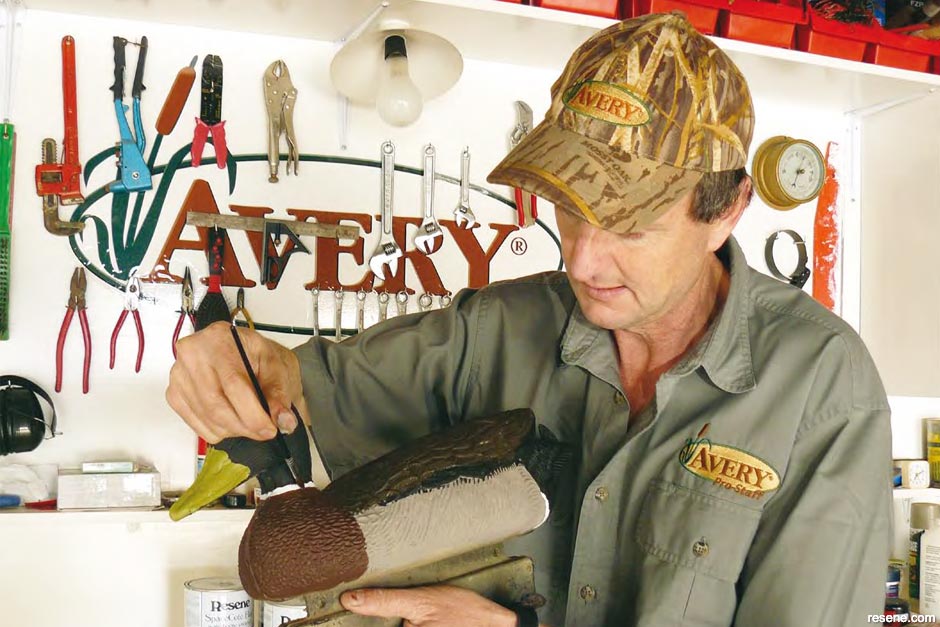
Dare I say it but this could even be an improvement on some ‘out of the box’ factory paint jobs that have many light, bright and shiny colours to attract the duck hunter rather than the duck.
Although that most basic approach to decoy painting will more than likely be a big improvement on many decoy spreads, I like to use some detail in my repaints to imitate the key features that I think will look very natural to the sharp-eyed and colour-sensitive Mallard at hunting ranges.
When I observe Mallards in various light conditions and from different distances, they appear predominantly very dark in colour, almost black in fact, with the only contrast being the chest and cheeks on the hens. These appear light in colour when catching the sunlight at certain angles. On the drakes, the occasional grey flank is visible but more visible is the contrast of the dark head and tail area.
Up close, some Mallard hens can be quite light – almost khaki – in colour. If we try to imitate this though, we will end up with decoys that, if wet or in bright sunshine, will shine up like beacons. We are far better to be conservative by using the darker colours and minimal lighter UV reflective colours. Also, remember that many of our Mallard hens are hybrids with Grey ducks so they are much darker in colour. Also, an added bonus is that dark colours can be more visible on water from long distances; some fishermen are known to paint the buoys on their crayfish pots black for this reason.
In Issue Four of NZ Hunter, I talked about decoy care and maintenance. I received considerable feedback from hunters who felt that the condition of their decoys was having a negative impact on their hunting success and they requested a ‘how to’ on decoy painting.
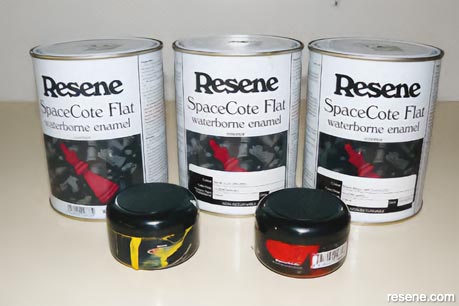
The paints needed
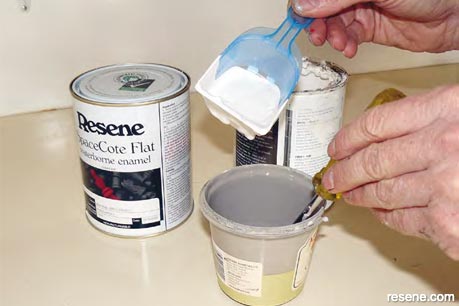
Mixing the paints
This can be as simple or as complex as you wish to make it. If you have plenty of time and artistic flair, you could no doubt airbrush a perfect Mallard imitation. I imagine though, that many duck hunters are like me; rather artistically challenged and always busy doing fun things, with little time for the more mundane tasks like painting – and of course we’d rather spend our hard-earned dollars on fun ‘big boys’ toys’ – not boring old cans of paint!
Although a highly detailed paint job will stand the scrutiny of a close inspection by a wary Mallard, even the most basic of repaints will improve your hunting success if your decoys are presently in a poor condition. This could be as simple as painting all your decoys a matt dark brown or even matt black. This would eliminate the biggest enemy of decoying ducks and that is shine or glare from faded or silt-covered decoys, as well as that blue/grey colour of worn plastic decoys that could be reflecting the wrong UV message.
I mix these paints to get the necessary colours. It is not that hard; just use small plastic containers, like the salad containers from the supermarket – or in my case – the potato and gravy pots from KFC! Mix the different paints to get the required colour. You will get some variation but that is not necessarily a bad thing and you will have the benefit of getting the shades that you think look right. Remember that colours will look darker once they have dried.
Now the main reason why we need to spend some of our good summer days painting decoys, is that once they are painted, we need a good hot, sunny day to bake the paint on. As matt paints are not that durable, it is important to do this. If we were to paint them only a week or two before duck season in cool weather, the paint will not dry or harden properly and will simply rub off. Sit your decoys out on a couple of good hot, sunny days and bake that paint on!
Updated note: Matt or flat paints are recommended. If you are using testpots, which are generally low sheen, you can apply Resene Concrete Clear Flat to achieve a flatter finish.
First we need to purchase our paint. If we were to buy a can of each colour required to duplicate all the colours on both a Mallard drake and a hen, we would need eight or more cans. And if you were to buy a primer and brushes etc you will have spent over $300. Then, if you want to paint Parries and geese as well – it will be more! You can buy a lot of new decoys for that money so I’ve simplified the process so we can paint not only Mallards but Parries and Canada geese as well, with just three 1 litre cans of paint and a couple of test pots. These are:
We need to prepare our decoys. All dirt and loose paint needs to be removed and this can be easily done with a wire brush or with a water blaster. A water blaster is the easiest method, especially if you make some sort of cradle to hold the decoys in place while you clean them, otherwise you’ll be chasing them all over the yard. Balancing on one leg while you hold the decoy down with your other foot is really not a good idea!
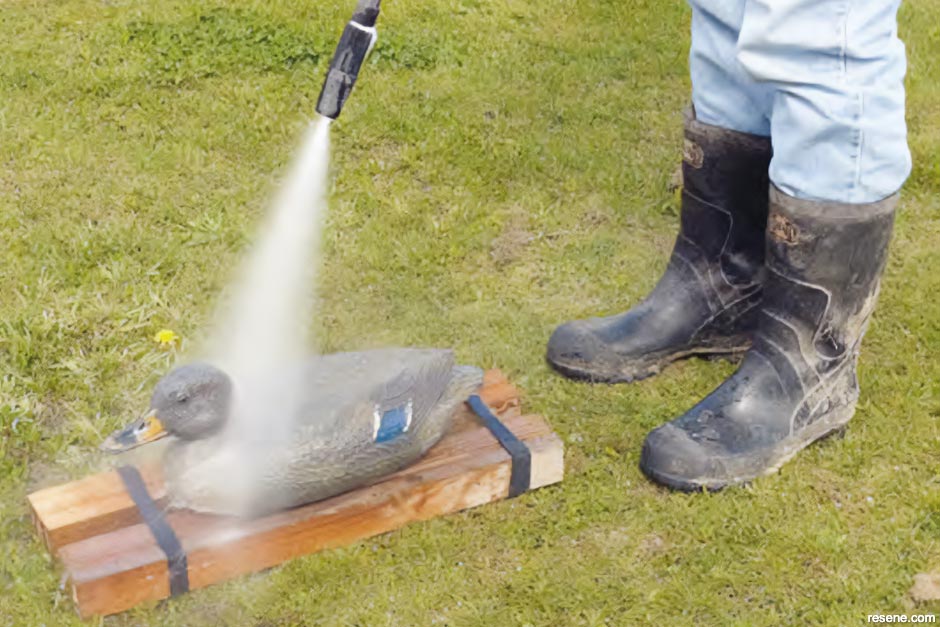
A simple way to hold the decoy while you're cleaning it in preparation for painting
Once the decoys are cleaned and dried, you need to decide if you are going to prime them before the final painting. If they still have a full coverage of original paint, it is probably not worth the added effort and cost as the primer may react with the existing paint. If the decoy has lost its original paint, you can be sure that any new paint you put on will also not stick to the plastic.
There are many types of primers designed to use on polyethylene-type plastics. Many are automotive or industrial paints so they are not cheap and you need to decide if it is worth the added expense or are you best to replace those decoys? Generally, I do not use a primer as I find that I need to give decoys a repaint every few seasons anyway, as paint will become faded. Even with a primer on, the paint will wear off pretty quickly if decoys are knocked around at all.
With my Mallard hen paint job, I attempt to imitate those features of a dark body with a lighter chest and cheeks. We want a dull-looking decoy, with only enough detail to pass the scrutiny of a close decoying duck, while avoiding using any extra lighter UV reflective colours and speculum that is a feature on so many factory paint jobs.
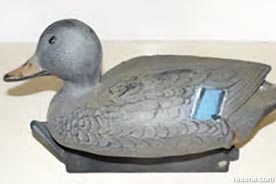
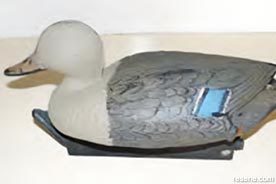
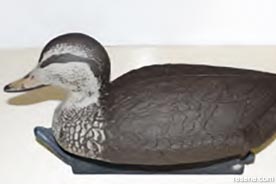
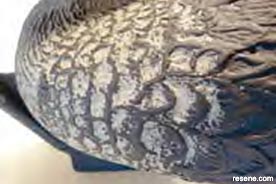
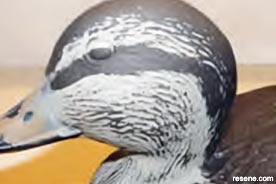
Step One: Paint the chest and head area a tan or khaki colour. On factory paintwork, this can vary from a yellowish creamy colour to a browny orange colour. I go for a much more neutral colour and create it by mixing some dark brown paint with a little white paint, then adding some of the yellow test pot till you get the desired colour.
Step Two: Once that is dry, I paint the back two thirds of the body with the dark brown, mixed with a little black. With a half-dry brush, lightly brush over the top of the feather detailing on the khaki chest of the decoy. If you were to do it the other way round and paint the whole body dark brown and then put the lighter colour on the feather detailing, in my experience, the effect is too bright. The back of the neck and top of the head is also painted with the dark brown/black mix. Then I paint a dark eye line, once again with a half-dry brush to give a ‘feathered in’ effect.
Step Three: Once dry, you can add some black paint to give a shadowing dimension around the wings and centre of the back, if desired. I paint the beaks black. Most Mallard hens no longer have orange beaks and as they are now usually black or dark olive, this is a much easier option! Your hen is now finished.
I discussed in Issue Four how most of our Mallard drakes have hybridised with Grey ducks so they are not at all like the North American Mallards that the factory paint jobs on our decoys try to imitate. This makes the painting of our decoys much easier, plus it gives us the option of varying the amount of grey we have on the bodies of our drake decoys to get an added look of realism.
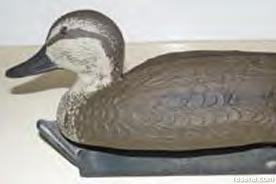
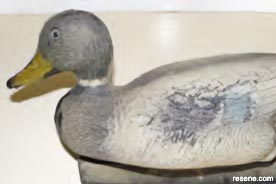
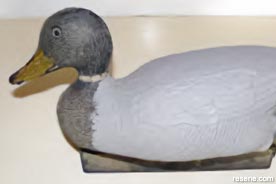
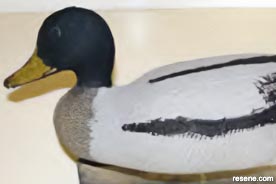
Step One: Firstly, mix some white paint with a little dark brown paint to get the desired creamy grey colour. If you mix black with white, you will get a blue/grey colour which is not at all natural. Paint the entire middle section of the decoy body grey.
Step Two: Once dry, paint the head and tail area black and also a strip of black runs up between the wings on the back and along the bottom edge of wing fold on the side of the decoy. Once again, a half-dry brush can be used to give some feathered detail on the rear wing tips.
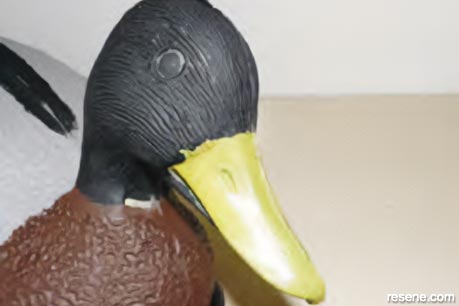
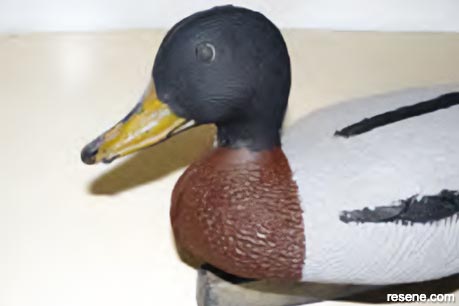
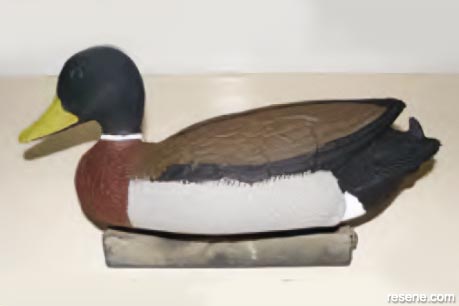
Step Three: When this coat is dry, we can paint the chestnut colour on the chest of the drake. I get this by mixing some of the dark brown with the some of the red test pot.
Step Four: I mix a small amount of the yellow test pot with some black to get a mustard colour to paint the drake’s beak.
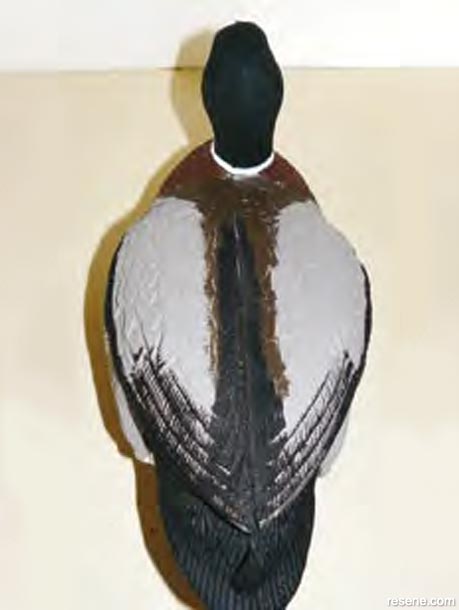
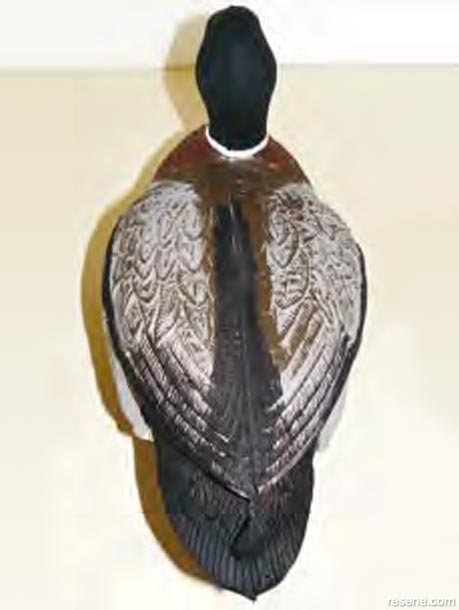
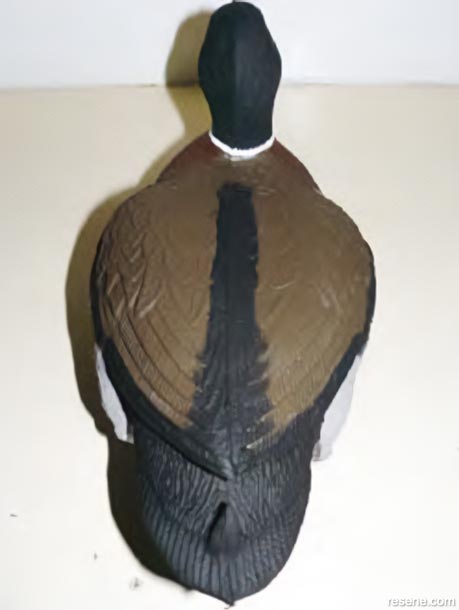
Step Five: Then I add the only white I use on my Mallard decoys and that is a thin white ring around the neck and a small white, triangular patch on the rump of the decoy.
Step Six: On the back of the decoy, paint a varied amount of the straight dark brown colour (not darkened like the hens) to get the hybrid look. To add variation to your decoy spread, some can have just a little patch of brown at the base of the neck. With others, I use a half-dry brush and cover just the high point on the feather detailing and on yet others, I will completely paint out the back with the dark brown. Your drake is now finished.
If you want to paint up your Canada goose decoys too, this can be done with the same cans of paint. The straight dark brown (Resene SpaceCote Flat Waterborne Enamel – Black Magic) is perfect for the bodies of the geese. The similar mix of dark brown/white/yellow that we used on the Mallard hen chests/cheeks can be used on the chest of the Canada geese, with maybe just a little more white (or less yellow) to get the right shade. Then of course, we have the matt black for the heads and tails, with the matt white for the cheeks and rump patches.
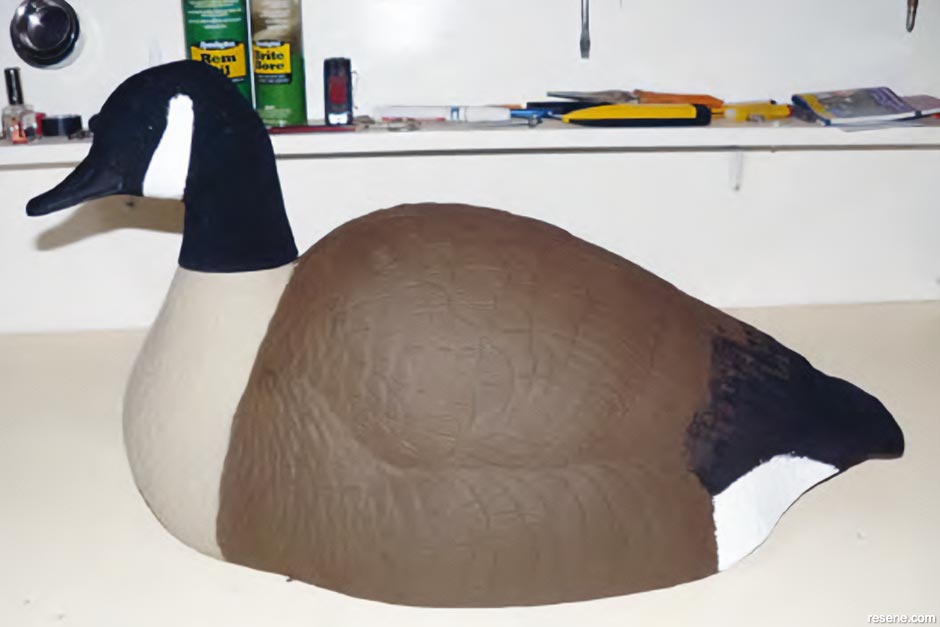
Our Parries will be even easier to paint! Obviously, we have the black for the male Parrie and the white for the head of the female and the side flashes on both sexes. The same chestnut colour we used on the chest of the Mallard drake (that we got from mixing the dark brown with the red test pot) will be perfect for the female Parrie body.
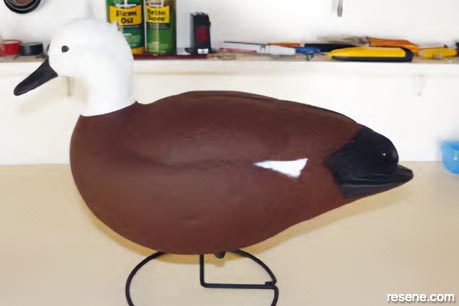
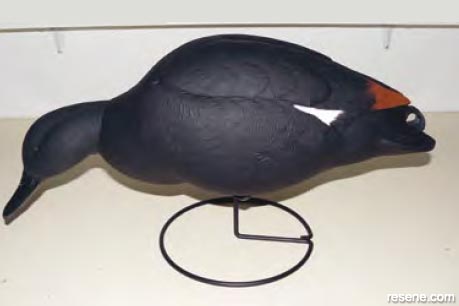
It really is that simple! Through the custom painting of your decoys, you will have some built-in variation to your decoys, which will only add to the realism of the spread. And by mixing your own colours, you can have them the shade you think is best, once again with some variation; not to mention the money you will save from having to purchase only three cans of paint.
Come next opening, you will have better results from hunting over more realistic and effective decoys and you will also have the satisfaction of knowing that a good part of that success was due to the time and effort you put in during the summer. As for the money you saved, you might have to spend that on some extra ammo because you’ll probably need it!
Small revisions have been made to product recommendations as alternatives to products that are no longer available.
› Download a PDF of this article
Updated 10 April, 2024
Written by Paul Stenning
NZ HUNTER 2009 – January / February
Weekend projects from Resene
Wanting to tackle a project at your place but only have a weekend to spare? Resene has joined forces with local designers and magazines to provide a large variety of projects and crafts to try